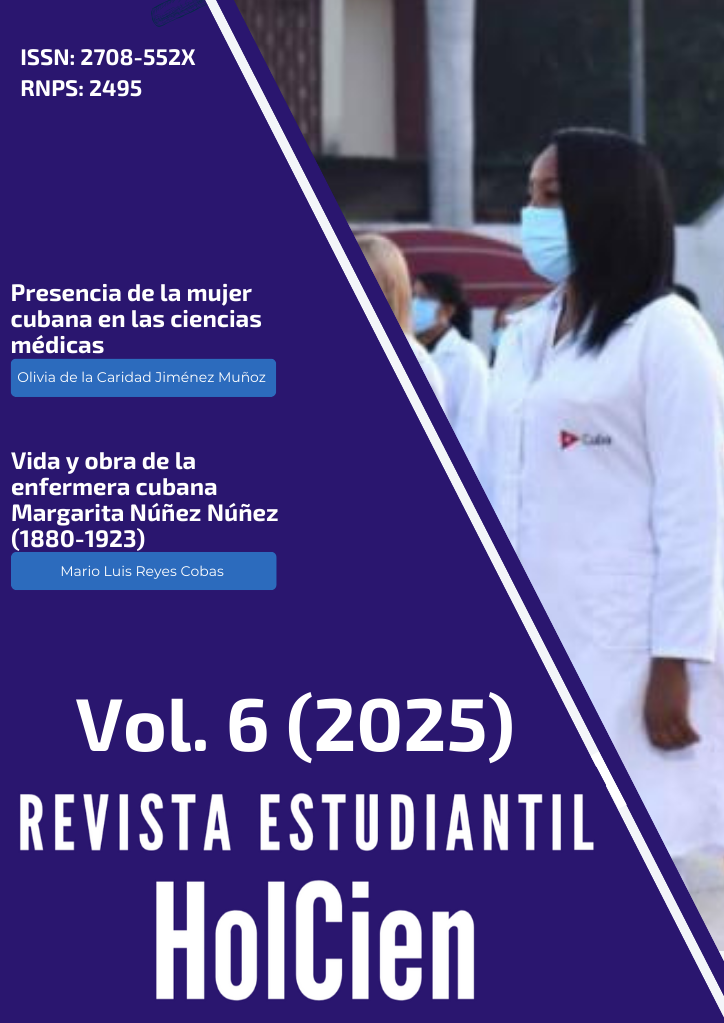Main characteristics of infections in newborns at the Neonatology Service. "Vladimir Ilich Lenin" General Hospital
Keywords:
bajo peso al nacer, infección neonatal, recién nacidoAbstract
Introduction: Associated infections in newborns are a matter of great concern, as they can significantly increase morbidity and mortality in this vulnerable population.Objective: To identify the main characteristics of infections in newborns at the Neonatology Service of Vladimir Ilich Lenin General Hospital between 2022-2023.Method: An observational, retrospective, descriptive, cross-sectional study was conducted in newborn patients with associated neonatal infection. The universe consisted of all newborns admitted to the Neonatology Service (1,356) and the sample was made up of 135 patients with neonatal infection. The variables analyzed were: gestational age, birth weight, type of delivery, risk factors, location of infection and microorganisms detected. The study was conducted through surveys and the results were presented in statistical tables.Results: The majority of newborns were preterm (70.3%) and had low birth weight (77.0%). Regarding the type of delivery, cesarean section was performed in 60.5%. According to associated risk factors, most patients were on mechanical ventilation (82.4%) and catheters were used (79.0%). The most common infection was respiratory infection (34.0%), while Enterobacter spp. was the most prevalent microorganism detected in 30.7% of cases.Conclusions: Neonatal sepsis is a life-threatening event for newborns and a challenge for neonatologists. It is essential to understand the main factors associated with it, in order to prevent the disease.
References
Alfonso Bibianes K, Rodríguez Swaby E, Duthil López S. Aspectos clínicos y epidemiológicos en pacientes con infección neonatal.Medisan.2016[citado 15/08/2025];20(8):1037-1046. Disponible en: http://scielo.sld.cu/scielo.php?script=sci_arttext&pid=S1029-30192016000800005&lng=es
Corral Pagan MT. Infecciones asociadas a la asistencia sanitaria en el servicio de Neonatología. Hospital Pediátrico. Holguín. 2018-2021 [Tesis].[Holguín]:Universidad de Ciencias Médicas; 2021.58p.Disponible en: https://tesis.hlg.sld.cu/downloads/2275/TESIS%20MARIA%20TERESA.pdf
Mendoza Reyes KE, Díaz CA. Perfil clínico epidemiológico de neonatos con infección asociada a la atención sanitaria en hospital especializado. Alerta.2022 [citado 15/05/2024];5(1):17-25. Disponible en: Disponible en: https://docs.bvsalud.org/biblioref/2022/02/1354399/perfil-clinico.pdf
Aríz Milián OC, Clemades Méndez AM, Faure Guerra J, Pérez Martínez Y, García Benavides N, Mederos Cabana Y. Sepsis neonatal de inicio precoz en una unidad de cuidados neonatales: gérmenes asociados. Acta Méd Centro. 2019[citado 14/7/2025];13(2):151-159.Disponible en: https://revactamedicacentro.sld.cu/index.php/amc/article/view/932
Ramos Salinas BMG. Características clínicas y epidemiológicas de sepsis neonatal en recién nacidos del hospital Hipólito Unanue de Tacna, 2016-2020[Tesis].[Tacna, Perú]:Universidad Nacional Jorge Basadre Grohmann;2021.Disponible en: Disponible en: https://repositorio.unjbg.edu.pe/server/api/core/bitstreams/d7940128-11a8-4269-9808-ce7f349fd190/content
Ferrer Montoya R, Montero Aguilera A, Pérez Dajaruch MÁ, Green Rutan M, Cedeño Escalona T. Factores de riesgo materno y neonatal en la infección probada de inicio precoz en pretérminos. Multimed.2020[citado 25/06/2025];24():1163-1182.Disponible en: http://scielo.sld.cu/scielo.php?script=sci_arttext&pid=S1028-48182020000501163&lng=es
Ostia Garza PJ, Salzar Espino B. Frecuencia de factores relacionados con sepsis neonatal. Perinatol Reprod Hum.2021[citado 15/05/2024];35(1).Disponible en: Disponible en: https://www.scielo.org.mx/scielo.php?script=sci_arttext&pid=S0187-53372021000100003
Cortés JS, Fernández LX, Beltrán E, Narváez CF, Fonseca-Becerra CE. Sepsis neonatal: aspectos fisiopatológicos y biomarcadores. MÉD.UIS. 2019[citado 06/05/2025];32(3):35-47.Disponible en: http://www.scielo.org.co/pdf/muis/v32n3/1794-5240-muis-32-03-35.pdf
Apaza Maquera V, Ticona Rendón M. Incidencia y complicaciones del recién nacido gemelar. RMB.2021[citado 15/05/2024];15(3):52-29.Disponible en: https://revistas.unjbg.edu.pe/index.php/rmb/article/view/1154
Alonso Uría RM, Rodríguez AB, González García S, Solernou Mesa IA, Ballesté López I, Oro Meriño L. Producción científica y su pertinencia con las líneas de investigación de neonatología en una institución docente. Rev Cubana Pediatr.2023 [citado 14/07/2025];95. Disponible en: http://scielo.sld.cu/scielo.php?script=sci_arttext&pid=S0034-75312023000100032&lng=es
Broche Candó RC, Vázquez Rodríguez MI, Sosa Palacios O, Trelles Porro L , Cubero Rego MA, Broche Candó JM.Infecciones neonatales tardías. Rev Cubana Pediatr .2021[citado 28/06/2025]; 93(Supl1). Disponible en: http://scielo.sld.cu/scielo.php?script=sci_arttext&pid=S0034-75312021000500004&lng=es
Lona Reyes JC, Pérez Ramírez RO, Rodríguez Patiño V, Cordero Zamora A, Gómez Ruiz LM, Llamas Ramos L.Prevalencia de β-lactamasas de espectro extendido en enterobacterias causantes de sepsis neonatal y factores asociados. Rev Chil Infectol.2019 [citado 15/05/2024]; 36(4):433-441.Disponible en: http://www.scielo.cl/scielo.php?script=sci_arttext&pid=S0716-10182019000400433&lng=es.
Published
How to Cite
Issue
Section
License
Copyright (c) 2025 Revista Estudiantil HolCien

This work is licensed under a Creative Commons Attribution-NonCommercial 4.0 International License.
Centro Provincial de Información de Ciencias Médicas. Universidad de Ciencias Médicas de Holguín. Cuba.
Política de acceso y distribución
El total de los artículos publicados son contribuciones de acceso abierto, que se distribuyen según los términos de la Licencia Creative Commons Atribución–NoComercial 4.0 que permite el uso, distribución y reproducción no comerciales y sin restricciones en cualquier medio, siempre que sea debidamente citada la fuente primaria de publicación.





